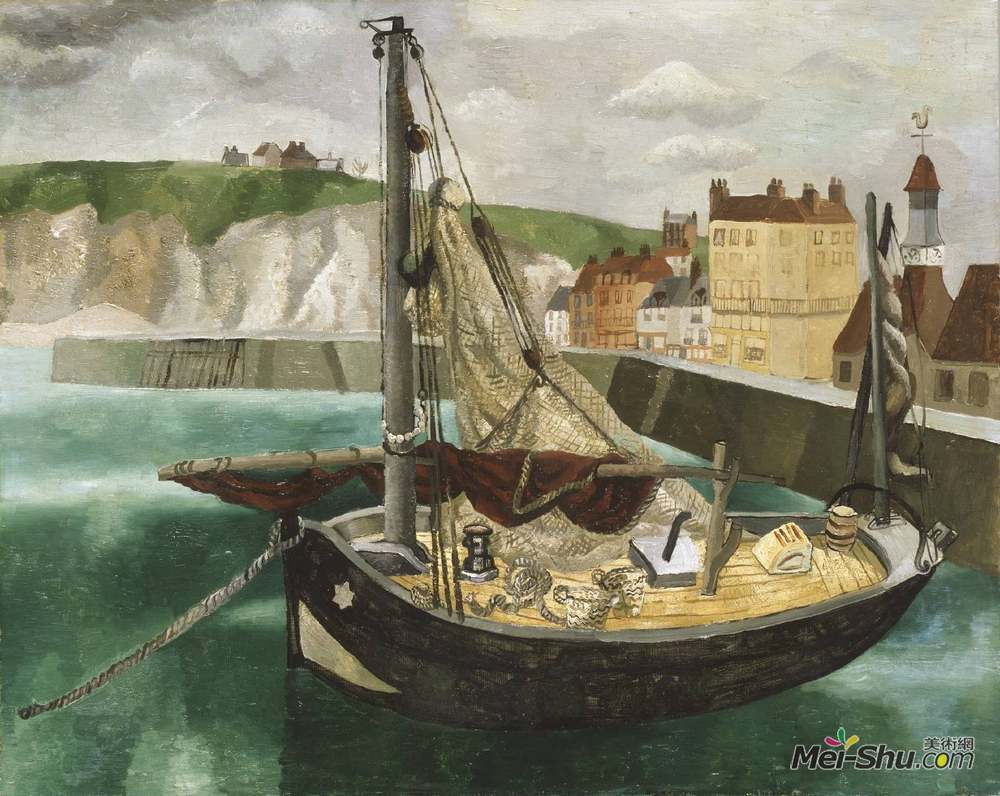 克里斯托弗·伍德(Christopher Wood)高清作品《迪佩普港的渔船》
克里斯托弗·伍德(Christopher Wood)高清作品《迪佩普港的渔船》
作品名:迪佩普港的渔船
艺术家:克里斯托弗·伍德
年代:1929
风格:后印象派
类型:玛丽娜
1929岁的伍德写信给他母亲,说他发现了一个很好的绘画场所。他是从迪耶普来的,几天前他和他的朋友Frosca Munster来的。诺曼底港以捕鱼船队带来的扇贝和鲱鱼而闻名,吸引了许多艺术家,尤其是画过该镇建筑物的沃尔特·西克尔特(1862-1942)和乔治·布拉克(1882-1963)。布拉克在1928访问了迪佩普,第二年在Varengeville附近建了一座房子和一个小工作室。他画了前滩和小船的研究,这是木头可能看到的。此外,迪埃普还提醒伍德注意圣艾夫斯,几个月前他曾和朋友本(1894-1982)和温妮弗里德·尼科尔森(1893-1981)住在那里。在那里,他对船只和渔民的传统生活着迷,而这个主题在他最后的几年里成了他绘画中重复出现的主题。迪亚普港的渔船是伍德20世纪20年代后期许多绘画的特征。排除Charles Harrison,比较了这些绘画和Alfred Wallis的作品(1855-1942)。伍德会见了沃利斯,一个隐居七十岁的康沃尔渔民,同时留在圣艾夫斯在1928。哈里森建议,在经常去沃利斯的工作室看他天真无邪的帆船画在不规则形状的纸板和木头片上之后,伍德的画“在形状和颜色上变得更加坚固”(哈里森,第189页)。伍德对沃利斯小画作设计的兴趣从他让船主宰构图的方式中显而易见。此外,正如Ingleby所说的,这艘船和大海的角度一样,就像一个桌面上的物体(英格比,P.213)。这使Wood本人成为一名经验丰富的水手,包括了设备和索具的细节。在港墙后面,他画出了高耸的悬崖,勒波莱特渔民的家园,还有一片风向标,看起来和现场的其他地方都不相称。伍德用黑色、白色、灰色和奶油做成的中性调色板,与许多在迪亚普拍的照片相比,迪亚普港的一艘渔船色彩丰富。绿松石般的大海和险恶的灰色天空与船上色彩鲜艳的房屋和黄色的木板形成鲜明对比。这幅画在香港仔美术馆和博物馆的藏品中展出。完成作品的组成。索菲·巴特利米建议他“把它(船)完全融入线条和色彩值的复杂相互作用中,创造出一种结构紧凑、简化严谨的构图”。
Title:A Fishing Boat in Dieppe Harbour
artist:Christopher Wood
Date:1929
Style:Post-Impressionism
Genre:marina
In 1929 Wood wrote to his mother that he had found 'a very good painting place'. He was writing from Dieppe where he had arrived a few days earlier with his friend Frosca Munster. The Normandy port, renowned for its scallops and herrings brought in by the fishing fleet, had attracted many artists, notably Walter Sickert (1862-1942) who had painted the buildings of the town, and Georges Braque (1882-1963). Braque had visited Dieppe in 1928, and built a house and a small studio in nearby Varengeville the following year. He painted the foreshore and studies of small boats, which Wood may have seen. Furthermore Dieppe would have reminded Wood of St Ives, where he had stayed with his friends Ben (1894-1982) and Winifred Nicholson (1893-1981) a few months earlier. There he had become fascinated with boats and the traditional life of fishing communities, a subject that was to become a recurring theme in his paintings during his last years.A Fishing Boat in Dieppe Harbour is characteristic of many of Wood's paintings from the late 1920s. Many art historians, including Charles Harrison, have made comparisons between these paintings and the work of Alfred Wallis (1855-1942). Wood had met Wallis, a reclusive seventy year old Cornish fisherman, whilst staying in St Ives in 1928. Harrison suggests that, following frequent visits to Wallis's studio to see his na?ve paintings of sailing boats on irregular shaped pieces of cardboard and wood, Wood's paintings became 'more robust in shape and colour' (Harrison, p.189). Wood's interest in the design of Wallis's little pictures is evident from the manner in which he allows the boat to dominate the composition. In addition, as Ingleby remarked, the boat 'is poised at an angle to the sea, like an object on a table top' (Ingleby, p.213). This enabled Wood, who himself was an experienced sailor, to include details of the equipment and rigging. Behind the harbour wall he paints the tall cliffs, the homes of the fishermen in Le Pollet and a weather vane, which appears to be out of scale to the rest of the scene. In contrast to many of the pictures Wood made at Dieppe, in which he used a neutral palette of black, white, greys and creams, A Fishing Boat in Dieppe Harbour is richly coloured. The turquoise sea and threatening grey sky contrasts with the brightly coloured houses and yellow wooden boards in the boat.A preparatory drawing for this painting in the collection of Aberdeen Art Gallery and Museums reveals that, despite its childlike appearance, Wood thought carefully about the composition of the finished work. Sophie Barthelemy suggests that he 'integrated it [the boat] fully into a complex interplay of lines, and colours values, creating a composition that is at once densely structured and rigorously simplified' .
作品名称:《迪佩普港的渔船》克里斯托弗·伍德(Christopher Wood)高清作品欣赏
作品链接:https://www.mei-shu.com/famous/26775/artistic-84320.html
作品类别:油画
免责声明:本站部分公开资料来源于互联网,目的是用于学术交流与讨论,并不代表本网赞同其观点和对其真实性负责。如果您认为我们的侵犯了您的权益,请与我们联系(banquan#mei-shu.com #替换为@),我们将在第一时间删除相关内容。